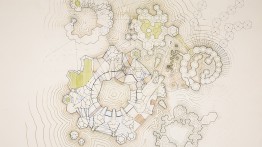Islands: Jacob S. Bang & Anne Romme AR'05
POSTED ON: September 22, 2022

This post—the third in a series highlighting projects from At the Intersection of Ideas and Material Conditions—features Islands, a project by Jacob S. Bang and Anne Romme AR'05, both faculty at the Royal Danish Academy.
The exhibition, currently on viewing the Third Floor Hallway Gallery, is part of an ongoing dialogue between faculty and students of The Irwin S. Chanin School of Architecture and the Institute of Architecture and Culture at the Royal Danish Academy. Faculty work from both schools was recently shown in Practices of Risk, Control, and Productive Failure, an exhibition held at the Brønshøj Water Tower in Copenhagen, Denmark from May 17 to June 10, 2022.
Romme and Bang describe their project as follows:
“Despite its well-defined boundaries, the island is a very fuzzy entity” states landscape architect Stefania Staniscia. (1) As a result of their geographic reality, islands, throughout history, have been used for isolation, political separation, and quarantine. Yet they are also used extensively as metaphors, embodying a variety of dichotomies without necessarily resolving them. The project Islands represents such an unresolved fuzziness. It investigates the island as having a non-binary relationship to its surroundings. It asks: What is an island if understood as an artistic problem of combining technology and accident, intent, and force?
Islands is a manifesto for giving form to new water-based inhabitation for a flooded future—a system of structures that simultaneously function as flood barriers, mooring platforms, and housing. Forms which are eaten up by internal structures, like a hermit crab or an abandoned cocoon. Morphologically, the structures are akin to coral reefs and algae. Sounds and smells come from the ocean. Their rhythms are in tune with the tide. They contain a seaweed harvesting plant, an obsolete oil rig, a birth clinic, and a crematorium at one and the same time.
All structures are in a constant state of flux, in an ever-changing symbiosis between accumulation and deterioration. The architect Raimund Abraham noted “While you build the wall, you shall destroy the stones.” (2) Likewise, the sculptor Willy Ørskov reminds us that building up and breaking down are not just opposites, but also necessary forces of creation. (3) It seems ever more relevant that architects work within these opposing, yet productive forces. Islands is inseparable from the working process in which the intentional and the unintentional are given equal value. The process of making and negotiation is inseparable from its form and intent. As we see an urgent need to find models for how architecture and urban development can grow organically and gradually, we engage directly in a process which does exactly that. Every piece of work passes between the two of us numerous times, as well as between digital and analog tools and methods.
There is no end result, as such. Sometimes the final object becomes so perforated or fragmented that it disintegrates. Other times, it merges with other islands to become an archipelago, or becomes its own double by being placed in relationship to a large mirror.
It is our intention to push our methods and materials towards boundaries, where the unexpected, and sometimes the undesirable, happens. Glitches in the transformation from digital to physical are accepted. We intentionally undermine the idea of the single author, the artist genius. We ‘destroy’ and erase parts of each other’s work, and allow for misinterpretations, faults, and mistakes. Just as we cannot always control water and keep it contained, our artistic research incorporates failure as a productive part of our practice.
1) Staniscia, S. “The “Island Effect”: Reality or Metaphor?” New Geographies 08 “Islands,” eds. Daou, D. and P. Perez-Ramos, Harvard University Press.
2) Abraham Raimund, [Un]built, Wien, 1996.
3) Ørskov, Willy, Aflaesning af objekter, Copenhagen, 1966.

Jacob Sebastian Bang is an associate professor at the Royal Danish Academy and the head of its BA program Helhed og Del/Whole and Part. His research interests are architecture and representation, and artistic methodology. He works within multiple media—painting, drawing, model-making, and graphical techniques.
Anne Romme AR'05 is an associate professor and the head of the Finder Sted/Taking Place program. She also runs an independent architecture practice invested in critical, experimental projects. Her work ranges from theoretical inquiries into the commons in architecture, to digital fabrication and the design of a building system based on pure plate shell structures.




